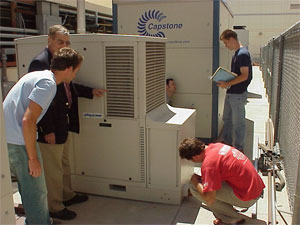(Sustainable) Power to the People
By Anna Lynn Spitzer
Irvine, Calif., April 2009 -- Developing sustainable energy technologies for the future is the mission at UCI’s Advanced Power and Energy Program (APEP).
In addition to its fuel cell research, APEP scientists investigate combustion technologies, distributed generation, co-generation, air-quality impacts and the hydrogen infrastructure.
|
Generating Solutions
Combustion technologies, distributed generation and combined heat and power (CHP) or combined cooling, heating and power (CCHP) are often pieces of the same puzzle.
In distributed generation (DG), electricity is generated at the site where it will be used, instead of being transmitted from large power plants. It can be produced by a number of small-scale technologies, including microturbines, photovoltaic cells, gas turbines and fuel cells.
The CHP or CCHP systems capture the waste heat from the fuel cells or combustion engines and reuse it. It is channeled into steam turbines to generate more electricity or through heat exchangers to generate hot water; waste heat can be used for heating and cooling buildings as well. This waste heat “recycling” improves the overall efficiency of the system and reduces pollutants released into the atmosphere.
The UCI Power Plant is such a system, using its waste heat for hot water. Vince McDonell, APEP associate director, says that when these systems are powered by the most advanced gas turbine engines, they produce the lowest emissions possible.
APEP has collaborated with the U.S. Department of Defense, installing test CHP units on military bases in Germany and the U.S., including one at a Northern California daycare facility at Ft. Ord. There, the system is powered by a refrigerator-sized 60-kilowatt natural gas-fired microturbine that provides the building’s electricity and hot water, and is also set up as an emergency generator.
If the region’s grid is up and running, the CHP system displaces both electricity and natural gas used to produce hot water. But if the grid goes down, the system replaces the lost electricity and provides heat to the building. McDonell says the research project exceeded expectations, even becoming a community gathering place during power outages.
While the custom DG systems are proving themselves effective, they also fuel the concept’s biggest dilemma.
Because each system must be unique, they are expensive to implement. “If you could find a generic application that would allow you to make one device that would work for everything, the price would come down and this technology could make a more substantial market penetration,” says McDonell, whose research includes seeking ways to reduce costs.
Search for Alternatives
APEP is also investigating alternative fuels that could power combustion engines. Possibilities include hydrogen, methane from landfills or waste treatment, and biodiesels derived from plant oils. “Combustion as a science is applicable to pretty much any combustion system,” McDonell says, but alternative fuels necessitate equipment adjustments. “If we do switch to a hydrogen economy, what would the implications be for all the boilers out there, all the gas turbine engines? I’m trying to figure out what would have to be done to allow them to use this new fuel or combinations of fuels in as clean and reliable a manner as possible.”
APEP’s fuel cell arm, the National Fuel Cell Research Center, is investigating other implications of a new hydrogen infrastructure, including pipelines, hydrogen generation stations, trucking requirements and impacts on air quality. It works hand-in-hand with vehicle manufacturers like Toyota and GM to test hydrogen-powered fuel cell vehicles, says Jack Brouwer, associate director.
Fuel cell vehicles, electric generation, distributed generation, co-generation and combustion technologies: all impact air quality in different ways. To get a better view of the big picture, APEP relies on computer modeling to predict the effects of various power-generation approaches on surrounding air quality. By modeling potential scenarios with changing variables within the Southern California basin, Brouwer says researchers hope to gain an enhanced understanding of how each will affect the region’s air quality in the future.
A sustainable future, they hope.


